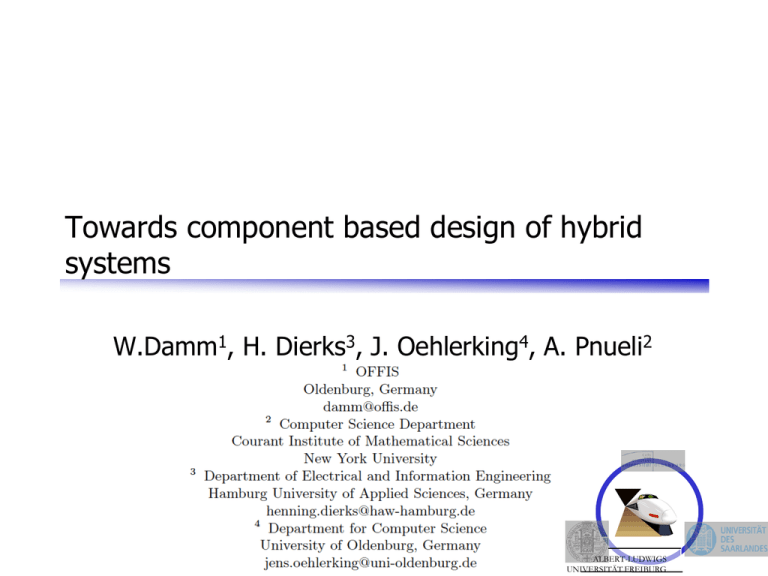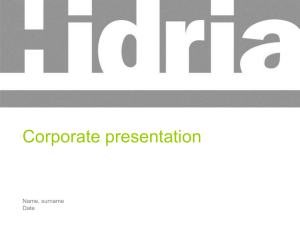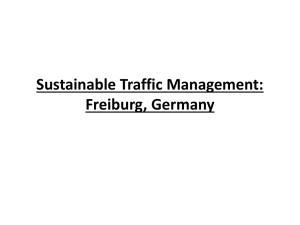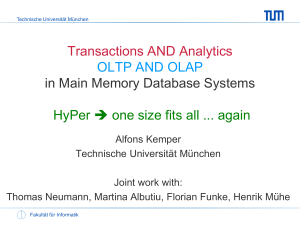slides
advertisement

Towards component based design of hybrid systems W.Damm1, H. Dierks3, J. Oehlerking4, A. Pnueli2 ALBERT-LUDWIGS UNIVERSITÄT FREIBURG Structure of Presentation • Motivation and Industrial Context • Hybrid Interface Specifications • Component Based Design of Hybrid Systems: Assuring Safety and Stability • Conclusion This presentation is based on a publication which will appear in the LNCS memorial volume dedicated to Amir Pnueli 2 ALBERT-LUDWIGS UNIVERSITÄT FREIBURG Motivation and industrial context 3 ALBERT-LUDWIGS UNIVERSITÄT FREIBURG ALBERT-LUDWIGS UNIVERSITÄT FREIBURG 5 ALBERT-LUDWIGS UNIVERSITÄT FREIBURG The underlying mathematics: hybrid automata 6 ALBERT-LUDWIGS UNIVERSITÄT FREIBURG Autosar Approach • Answers requirement to decouple growth in number of functions from decoupling number of ECUs: – SW components of different functions can be allocated to one ECU – Allows SW components of one function to be distributed over multiple ECUs (to optimize overall architecture) • Components can correspond to different modes or subsystems of hybrid controllers Induces distributed execution Mode switching can cause task switching ALBERT-LUDWIGS UNIVERSITÄT FREIBURG Towards component based design of hybrid controllers Can we propose a component model for hybrid controllers … supporting re-use of components in multiple application contexts? – Characterizing stability and safety properties in specified environments through hybrid interface specifications … supporting incremental construction of hybrid controllers – From a library of controller models – by composing controllers through transition composition – automatic verification of hybrid interface specification of composed system from interface specifications of subsystems … allowing to bridge the gap between specification and design – Specification models with idealized time behaviour – Distributed implementation with induced impurities 8 such as latencies in mode-switching ALBERT-LUDWIGS UNIVERSITÄT FREIBURG Hybrid Interface Specifications 9 ALBERT-LUDWIGS UNIVERSITÄT FREIBURG Requirements on Hybrid Interface Specifications 1. Characterize plant regions for which safety and stability is guaranteed 2. Support compositional reasoning for safety and stability 3. Support transition from specification models to design – Specification models • Focus on nominal behaviour • Assume instantenous observability and controllability of plant – Design models • control-laws become tasks: support activation/suspension of components • provide exception handling adressing antitipated risks or failures • cater for task-switching latencies 10 ALBERT-LUDWIGS UNIVERSITÄT FREIBURG The inner envelope design paradigm Consider a safety property given as conjunction of linear constraints. We identify an inner envelope o with the following properties 1. any only slightly perturbed trajectory originating in o stays there forever 2. whenever a sampled trajectory leaves o , then there is a time window of length at least until is violated when extrapolating the current dynamics even taking into account the specified worst-case dynamics for unmodelled disturbances 11 ALBERT-LUDWIGS UNIVERSITÄT FREIBURG … and how we apply it Choose as entry condition an inner envelope of safe such that all slightly disturbed trajectories originating in it will converge to (inner envelope) region of stability within specified bound safe0 stable stable0 Similarly for stable safe set-point 12 ALBERT-LUDWIGS UNIVERSITÄT FREIBURG Raising alarms along bad trajectories safe0 stable stable0 safe set-point 13 Combin ing Modes ALBERT-LUDWIGS UNIVERSITÄT FREIBURG A Component Lifecycle: three roles 1. Control under nominal conditions – – Ensure plant safety Enforce convergence of plant according to stability requirements (asymptotic stability, drive plant into specified region within given time bound) 2. Deviations from nonimal conditions: – – Detect risks for endangering safety and stability Raise alarm early to provide for safe transition of control 3. Offering help – Check for raised alarms and offer help if component spec can adress dynamics causing alarm 14 ALBERT-LUDWIGS UNIVERSITÄT FREIBURG Approach • Components provide – Inports: • To invoke nominal service • To offer help • To specify plant conditions for which help can be offered – Outports • To raise alarms • To characterize plant conditions causing alarm • Components can raise multiple alarms • Conditions causing alarm can disappear 15 ALBERT-LUDWIGS UNIVERSITÄT FREIBURG Specification of nominal behaviour • Stability requirements – this subsumes asymptotic stability – the controller is required to meet the stability requirements unless an alarm is raised • Safety requirements – the controller is required to meet the plant safety requirement unless an alarm is raised 16 ALBERT-LUDWIGS UNIVERSITÄT FREIBURG Being helpful: specification of inports Is given by where cβ λβ takeβ startβ Mmm signals an incoming alarm is the latest reaction time for granting acceptance signals acceptance of alarm is the verdict of the distributed alarm resolution protocol to become the hero is the entry predicate required to be satisfied when control is transferred to the component over this port 17 ALBERT-LUDWIGS UNIVERSITÄT FREIBURG Asking for help: specification of outports Is given by where bα μα Δα takeα switchα Mmm is the outgoing alarm signal is the plant condition causing the alarm is the minimal persistency of the alarm is the duration following the alarm for which safety and stability is still guaranteed signals that at least one helper is available signals delegation of control to helper overapproximates plant state at switch time 18 ALBERT-LUDWIGS UNIVERSITÄT FREIBURG • Static interface – Data – Control 19 ALBERT-LUDWIGS UNIVERSITÄT FREIBURG • Inport specifications • Outport specifications 20 ALBERT-LUDWIGS UNIVERSITÄT FREIBURG • Stability requirements • Assumptions • Promises 21 ALBERT-LUDWIGS UNIVERSITÄT FREIBURG Hierarchical component based design and verification ALBERT-LUDWIGS UNIVERSITÄT FREIBURG Hierarchical construction of controllers actuators sensors Plant 23 ALBERT-LUDWIGS UNIVERSITÄT FREIBURG 24 25 26 ALBERT-LUDWIGS UNIVERSITÄT FREIBURG 27 ALBERT-LUDWIGS UNIVERSITÄT FREIBURG 28 ALBERT-LUDWIGS UNIVERSITÄT FREIBURG 29 ALBERT-LUDWIGS UNIVERSITÄT FREIBURG 30 ALBERT-LUDWIGS UNIVERSITÄT FREIBURG 31 ALBERT-LUDWIGS UNIVERSITÄT FREIBURG Sequential composition of components Pragmatics All subsystems offer alternate ways of controlling same plant Choice of subsystem dependent on current dynamics if current subsystem is no longer able to ensure stability and safety objectives, a warning is raised using one of its exits Control then either switches to other subsystem, or warning is passed to enclosing hierarchy level Hence all subsystems share same static interface and safety and stability requirements relate to same equilibrium 32 ALBERT-LUDWIGS UNIVERSITÄT FREIBURG Finding the hero among all offering help • In a context of incremental distributed controller desing, all of these might offer help – 5 neighbours on the same level of the hierarchy, but allocated on different Electronic Control Units – Some not yet known friend in a so-far unspecified environment of the component • Need distributed agreement protocol to ensure unique transfer of control – Wrapper for each component – Negotiates with other components who will be the hero using protocol on control-signals • Alarms, I can take this, Please do so, Activate, Suspend • Specified for each inport 33 ALBERT-LUDWIGS UNIVERSITÄT FREIBURG Real-time requirements for negotiation Negotiations must be closed before system becomes unsafe – Critical component promises to maintain safety and stability for fixed time period after raising alarm – taking into account costs for context switches – Alarms must ensure minimal persistency to guarantee distributed idenfication of helper – Helpers must provide offer in given time window – Once helper is selected, it still takes tau time units to perform context switch 34 ALBERT-LUDWIGS UNIVERSITÄT FREIBURG Distributed agreement on heroes ... 35 ALBERT-LUDWIGS UNIVERSITÄT FREIBURG Semantics of transition composition • Let [[Ci]] denote hybrid automata expressing the semantics of subsystem Ci . • We define the semantics [[C]] of the transition composition C = S(P,Q)(C1,...,Cn) as the parallel composition of hybrid automata – [[Ci]] – HC representing the semantics of its subcomponents propagating activation and failures: it implements – HQ propogating control signals from inports: it implements – HP implementing distributed identification of 36 hero ALBERT-LUDWIGS UNIVERSITÄT FREIBURG Distributed identification of heroes ... Automaton codes in its state set • internally raised alarms • if for such an alarm helpers are available all such pairs (alarm, helper) Collects to this end all control signals from local outports and control signals of local inports and external outports based on P-Port connection 37 ALBERT-LUDWIGS UNIVERSITÄT FREIBURG Compositional Verification of stability - Approach In a white-box view we would consider the composed Lyapunov functions V() X | if in(Cj) then Vj(,X) as a candidate Lyapunov function for the composed system and prove, that this function is decreasing A key ingredient in this proof is, that criticality does not increase in mode switching 38 ALBERT-LUDWIGS UNIVERSITÄT FREIBURG Lyapunov functions demonstrate convergence to equilibrium • Lyapunov function provide measures of criticality of states of the closed loop H||P: red states are far from point of equilibrium • Lyapunov functions are witnesses of stability: any trajectory originating in entry-region of controller will converge to equilibirum 39 ALBERT-LUDWIGS UNIVERSITÄT FREIBURG 40 ALBERT-LUDWIGS UNIVERSITÄT FREIBURG Turning a hybrid automata into a basic component implementation • Have to provide for activation and suspension • Have to provide wrapper supporting distributed agreement protocol • Leads to hybrid automata defining component semantics • Can verify with automated verification techniques that hybrid automata meets component interface specifications – Nominal: safety and stability – Specifications of inports (partly guaranteed by wrapper automata) – Specifications of outports (partly guaranteed by wrapper automata) 41 ALBERT-LUDWIGS UNIVERSITÄT FREIBURG Semantics of basic components Let be a hybrid automata admissable for component specification C and plant P. We define the semantics of the induced component implementation I [[C(H)]] as the parallel composition of hybrid automata with H1 H2 H3 Hβ allowing for chaos when I is not active providing for activation and suspension of H supporting distributed agreement on handling all alarms supporting protocols for inports 42 ALBERT-LUDWIGS UNIVERSITÄT FREIBURG Interface verification of basic components (I) Let denote the hybrid automata inducing the basic component implementation, and consider the closed loop H ||P . Recall that a Lyapunov function for H||P is a function meeting the following requirements 43 ALBERT-LUDWIGS UNIVERSITÄT FREIBURG Verification conditions for basic components (1) No chattering – no immediate alarms where reach refers to the linear(!) closed loop dynamics of H||P Tools for establishing verification conditions: using barrier certificates/Lyapunov functions using forward reachability analysis tools such as PHAVER 44 ALBERT-LUDWIGS UNIVERSITÄT FREIBURG Verification conditions for basic components (2) • Asymptotic stability – Generate family of Lyapunov functions to provide more flexibility when composing systems – for H||P • Time bounded convergence – We exploit that any linear combination of a Lyapunov functions is again a Lyapunov function – Let and 45 ALBERT-LUDWIGS UNIVERSITÄT FREIBURG Verification conditions for basic components (3) • Exit conditions are established within escape period • Promises are met Theorem If all verification conditions are satisfied, then H||P satisfies its hybrid interface specification 46 ALBERT-LUDWIGS UNIVERSITÄT FREIBURG Inductive Assertions As a basis for compositional grey box verification, we must provide the following „invariants“ inductively at the interface of components Additionally, parameter dependent constants for computing convergence rates must be made visible 47 ALBERT-LUDWIGS UNIVERSITÄT FREIBURG Conclusion and Future Work ALBERT-LUDWIGS UNIVERSITÄT FREIBURG Conclusion • Have proposed theoretical foundation for component based design of hybrid control supporting compositional verification of nominal and exception handling requirements • Verification conditions both for basic and composed systems can be discharged automatically • Future work – Extensions to parallel composition – Bridging the gap between idealized plant models and physical plants 49 ALBERT-LUDWIGS UNIVERSITÄT FREIBURG Thanks, Amir 50 ALBERT-LUDWIGS UNIVERSITÄT FREIBURG







